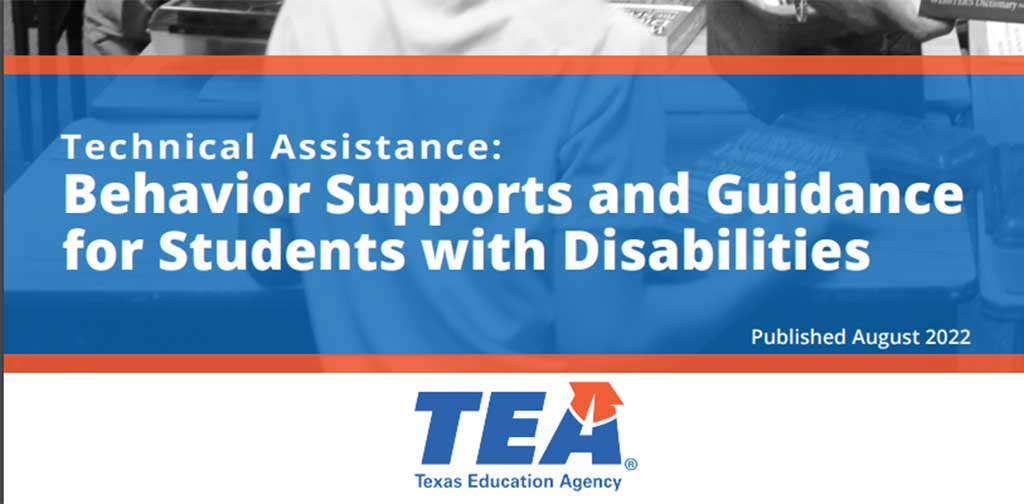Texas regulations (TAC 89.1055) require ARD/IEP committees to consider eleven strategies for students with autism. Schools sometimes use the term “Autism Supplement” to refer to a form that they use at ARD/IEP meetings to address these strategies. This fact sheet can help parents in the development of adequate and appropriate strategies for their child with autism.
While all eleven strategies must be considered, TEA does not require that all be implemented. The ARD/IEP committee determines which strategies should be included in a child’s IEP. If it is decided that services are not needed in one or more area, the IEP must include a statement to that effect and the “basis upon which the determination was made.” “The statement may address the services collectively or individually.” (TX Administrative Code, and the TEA Autism Guidance document)
Schools must consider strategies based on peer reviewed, research-based educational practices to the extent practicable. The U.S. Department of Education says peer-reviewed research “generally refers to research that is reviewed by qualified and independent reviewers to ensure that the quality of the information meets the standards of the field before the research is published. However, there is no single definition of ‘peer-reviewed research because the review process varies depending on the type of information to be reviewed.” They also say “to the extent practicable…generally means that services and supports should be based on peer-reviewed research to the extent that it is possible, given the availability of peer-reviewed research.”
If a school uses a specific form to address the eleven strategies, it is important that this document support and not contradict other parts of the IEP. For example, speech goals/objectives and staff ratios in the IEP should be consistent with what is listed in strategies 7 and 8.
Strategy 1 is extended educational programming (for example: extended day and/or extended school year services that consider the duration of programs/settings based on assessment of behavior, social skills, communication, academics, and self-help skills).TEA notes this should be based on an assessment of the individual student’s needs. The Guidance document says that the “ARD committee should consider a student’s functional communication system, which may require instruction and intervention beyond the normal school schedule. The same may be said for interpersonal and behavioral skills, based on an assessment of individual student need.” The 2007 report on Autism by the American Academy of Pediatrics (AAP) says that an “effective early childhood intervention” includes “provision of intensive intervention, with active engagement of the child at least 25 hours per week, 12 months per year, in systematically planned, developmentally appropriate educational activities designed to address identified objectives.”
Strategy 2 is daily schedules, reflecting minimal unstructured time and active engagement in learning activities (for example: lunch, snack, and recess periods that provide flexibility within routines; adapt to individual skill levels; and assist with schedule changes, such as changes involving substitute teachers and pep rallies). The AAP report says that effective interventions should have “a high degree of structure through elements such as predictable routine, visual activity schedules, and clear boundaries to minimize distractions.”
Strategy 3 is in-home and community-based training or viable alternatives that assist the student with acquisition of social/behavioral skills (for example: strategies that facilitate maintenance and generalization of such skills from home to school, school to home, home to community, and school to community). TEA guidance says that a “student with autism may have difficulty generalizing skills from one environment to another. In-home/community-based training is an option an ARD committee may choose for a student with autism in order for them to learn or reinforce social skills in a variety of settings.”
Strategy 4 is positive behavior support strategies based on relevant information (for example: (a) antecedent manipulation, replacement behaviors, reinforcement behaviors, reinforcement strategies, and data-based decisions; and (b) a behavior intervention plan developed from a functional behavioral assessment that uses current data related to target behaviors and addresses behavioral programming across home, school, and community-based settings). The TEA guidance document notes that these are examples of potential strategies rather than a requirement to use a specific methodology. The examples are some of the specific strategies/processes that have been shown to be effective for students with autism, but are not all possible strategies. It notes that the ARD has the responsibility of selecting interventions based on the unique needs of each student and there is no one-size-fits-all approach to providing services to students with autism. It is important that this item be coordinated with strategy 9, social skills and strategies. Often “problem behaviors” are a result of deficits in social skills.
Strategy 5 addresses that beginning at any age, but at least by age 16 futures planning for integrated living, work, community, and educational environments must begin that considers skills necessary to function in current and post-secondary environments.
Strategy 6 covers parent/family training and support, provided by qualified personnel with experience in Autism Spectrum Disorders (ASD), that, for example: (a) provides a family with skills necessary for a child to succeed in the home/community setting; (b) includes information regarding resources (for example: parent support groups, workshops, videos, conferences, & materials designed to increase parent knowledge of specific teaching/management techniques related to the child’s curriculum); and (c) facilitates parental carryover of in-home training (for example: strategies for behavior management and developing structured home environments and/or communication training so that parents are active participants in promoting the continuity of interventions across all settings). TEA guidance is limited on resources and access to resources, only adding that schools should provide information regarding available local resources. Even though Texas has many rural areas, and local resources are often limited, there is no guidance on what local means. Some schools and Education Service Centers provide funding for parents to attend workshops and conferences in and outside of their Service Center Region.
It is noted that parent training should be offered that fosters continuity across settings and focuses on generalization of IEP-related skills and include areas such as behavior management, interpersonal skills, communication training and/or structured environments across all settings. It notes that the provision of in-home training should be based on the individual needs of the student. It says that training could be a person working “face-to-face” with parents and/or the student or could be providing a videotape to the family to teach/learn specific skills. It is important that staff, especially paraprofessionals, working with a family have appropriate and on-going training. This item should also be coordinated with strategy 10.
Strategy 7 is providing a suitable staff-to-student ratio appropriate to identified activities and as needed to achieve social/behavioral progress based on the child’s developmental and learning level (acquisition, fluency, maintenance, generalization) that encourages work towards individual independence (as determined by, for example: (a) adaptive behavior evaluation results; (b) behavioral accommodation needs across settings; and transitions within the school day). TEA guidance says ARDs make these decisions on an individual basis considering the setting, a student’s communication abilities, and present level of competence in each area of instruction. It also notes that as a student makes progress, “there should be less adult supervision, more self-monitoring and therefore, a higher staff to student ratio.” While not stated, the implication is that the school is working towards increased individual independence.
Strategy 8 addresses communication interventions, including language forms and functions that enhance effective communication across setting (for example: augmentative, incidental, and naturalistic teaching). TEA guidance says that staff “may wish” to consider these items and “language forms and functions that enhance effective communication across settings. Teachers should also consider a student’s style of learning and the portability of a communication strategy.” Strategy 1 mentions a student’s functional communication system. One source says “Simply said, functional communication is not just about speaking; it’s about making yourself understood, even if it means using an aid like a communication board, or speech generating device. It’s also about being able to do this independently; just saying yes or no in response to a question does not fit the definition of
functional communication.”
Strategy 9 is about social skills supports and strategies based on social skills assessment/curriculum and provided across settings (for example; trained peer facilitators (e.g., circle of friends), video modeling, social stories, and role playing). TEA does not add any additional information to this item. However, it should be noted that social skills assessments and curriculum exist and educators and parents should be aware of them for a variety of students, in addition to those with autism. It is also important that this item is correlated with social skills goals in the IEP. As mentioned, this should be coordinated with strategy 4.
Strategy 10 covers professional educator/staff support (for example: training provided to personnel who work with the student to assure the correct implementation of techniques and strategies described in the IEP). TEA simply notes that schools “are responsible for training teachers and paraprofessionals to effectively implement programs for students with autism. Training may include a foundation of scientifically-based research intervention strategies.” What is not mentioned is the importance of providing this support in a timely manner. Parents should request that the IEP state a timeline for doing this. If this is not done, the parent should request a written statement of why the school is not willing to state a timeline. It is also important that the parent and school monitor that these supports and, sufficient training are provided and the provision is documented.
Strategy 11 is on teaching strategies based on peer-reviewed, research-based practices for students with autism (for example: those associated with discrete-trial training, visual supports, applied behavior analysis, structured learning, augmentative communication, or social skills training). TEA notes that the strategies listed are only some of many instructional options that the ARD committee can consider, but does not list any additional options. They then state that while “it is the responsibility of an ARD committee to make decisions regarding appropriateness of strategies based on the unique needs of an individual student, there is no one-size-fitsall approach to providing services to students with autism.” This statement reflects decisions made in numerous court cases. However, it is important and appropriated for parents to monitor and question whether their child is making reasonable progress under the method being used. If the child is making little or no progress and/or it appears that the school is using a “one-size-fits-all approach” without considering the unique needs of the child, the parents have a basis for challenging the method being used.



